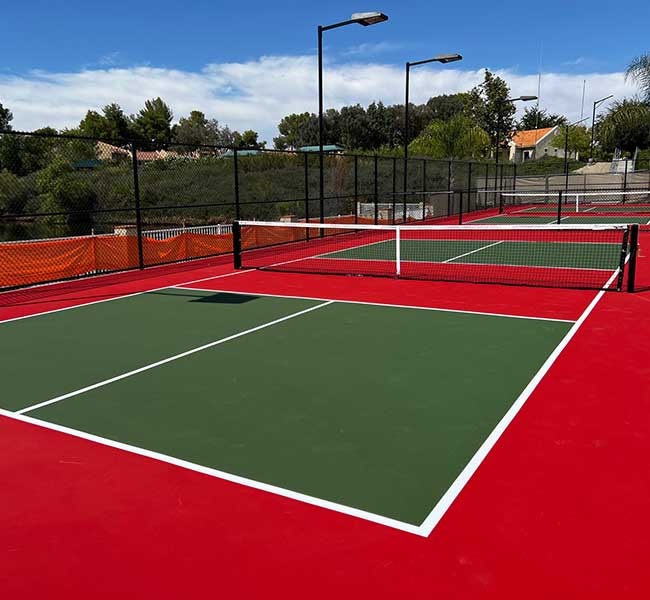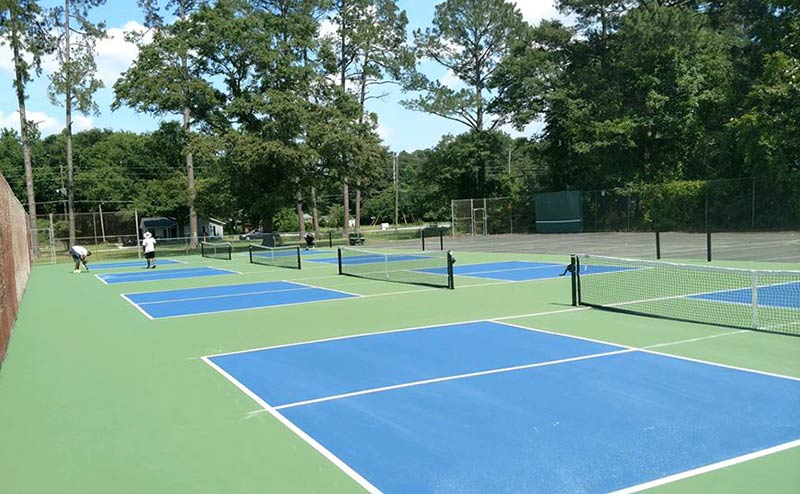Lasting Practices in Pickleball Court Building And Construction You Ought To Know
As the appeal of pickleball proceeds to climb, so too does the requirement for lasting techniques in court construction. This approach not just addresses environmental issues however likewise improves the long life and performance of the courts. From picking eco-friendly materials to carrying out efficient drainage and energy-saving illumination options, there are many methods to think about. Yet, the effect of these methods prolongs far beyond the court itself. Understanding exactly how each element adds to an extra sustainable future invites better expedition into the detailed balance in between leisure growth and environmental stewardship.
Choosing Eco-Friendly Products
Selecting eco-friendly products is a critical action in the construction of sustainable pickleball courts. The option of sustainable materials not just reduces ecological impact yet likewise boosts the longevity and efficiency of the court. Key products include reused rubber for the surface area, which uses superb toughness and shock absorption while drawing away waste from land fills.
Furthermore, using in your area sourced products lowers transport exhausts and sustains regional economies. Pickleball court construction. For instance, utilizing native hardwoods for fence and seating can offer a sustainable aesthetic while making certain resilience versus the aspects.
Including absorptive materials for court foundations can further add to sustainability by enabling for all-natural water drainage and reducing drainage. These choices not only secure regional environments however also advertise healthier play settings.
Effective Drainage Solutions
While the selection of environment-friendly products is important, applying effective drain options is similarly vital for maintaining lasting pickleball courts. Correct drain not just safeguards the court surface area from water damages but additionally lessens erosion and drainage, promoting ecological stability.
Reliable drain systems can consist of permeable paving, which enables water to infiltrate the ground as opposed to merging on the surface. This minimizes the probability of standing water, which can result in mold and mildew and other upkeep problems. In addition, integrating purposefully placed drain channels and swales can route excess water far from the court area, guaranteeing a completely dry having fun surface area and avoiding dirt erosion.
Making use of indigenous greenery in the landscape design around the courts can even more improve drain by soaking up excess water and lowering drainage. These plants need much less irrigation and promote biodiversity, lining up with lasting techniques.
In addition, it is critical to routinely keep the water drainage system to ensure its long-lasting efficiency. This consists of clearing up particles and tracking for obstructions. By focusing on reliable drainage solutions, pickleball court constructors can substantially add to the sustainability and long life of the center, inevitably benefiting both gamers and the setting.
Energy-Efficient Lights Options
As the need for pickleball remains to expand, incorporating energy-efficient lights alternatives right into court layout has actually ended up being progressively vital for sustainability. Standard lighting systems commonly take in too much my sources power, adding to greater operational expenses and ecological influence. Taking on modern, energy-efficient technologies is essential for both new building and constructions and remodellings.
LED (Light Emitting Diode) lights stands apart as a leading choice as a result of its durability and power savings (Pickleball court construction). Contrasted to traditional illumination, LEDs use around 75% much less power and can last as much as 25 times longer, significantly reducing maintenance expenses. Furthermore, the directional nature of LED illumination minimizes light pollution, guaranteeing that illumination is focused on the court rather than bordering areas.

Lasting Surface Alternatives
Checking out lasting surface area choices for pickleball courts has gotten traction among building contractors and gamers alike. The focus on green products not just aligns with the growing ecological awareness yet additionally enhances the efficiency and sturdiness of the courts.
This material provides superb shock absorption, minimizing the risk of injuries for gamers while promoting sustainability. These tiles are very easy to mount and replace, and their flexibility enables for different court configurations.
All-natural turf courts are likewise becoming a lasting selection, promoting biodiversity and reducing the warm island effect. Nonetheless, they need normal maintenance and water, which might not line up with all sustainability objectives.

Water Conservation Methods

Another reliable method entails the setup of rainwater harvesting systems. These systems save and gather rain for usage in preserving court surface areas and landscaping. This strategy not only preserves potable water however also reduces dependence on municipal sources.
In addition, utilizing drought-resistant landscape design around the courts is vital. Indigenous plants require less water and are better adjusted to neighborhood environment conditions, thus reducing total water consumption. Additionally, using efficient irrigation systems, such as drip watering, ensures that water is provided straight to plant origins, decreasing evaporation and waste.
Conclusion
Including sustainable practices in pickleball court building and construction substantially contributes to ecological conservation and source effectiveness. By focusing on these methods, the construction of pickleball courts can line up with more comprehensive environmental objectives while promoting durability and capability within communities.
As the popularity of pickleball continues to increase, so also does the need for sustainable techniques in court construction.Selecting green materials is a crucial step in the building of sustainable pickleball courts. By focusing on energy-efficient illumination alternatives, pickleball court fabricators can add to an extra lasting future while fulfilling the requirements of gamers and stakeholders alike.Integrating sustainable surface options not only improves the performance of pickleball courts but also paves the method for carrying out reliable water preservation methods.Integrating sustainable practices in pickleball court construction significantly contributes to ecological conservation and resource efficiency.